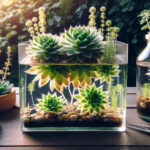Introduction to Water Propagation of Sedum
Imagine a plant that can multiply from mere fragments into lush botanical displays, a true phoenix from the ashes—or rather, from the water! This isn’t a fantasy scenario; it’s the reality for sedum enthusiasts who are diving into the adventurous waters of propagation. Sedum, a beloved succulent, is making waves among gardening hobbyists and commercial growers alike for its hardy nature and aesthetically pleasing vibes.
Gone are the days when soil was the sole sanctuary for plant propagation. Water rooting—the process of propagating plants in water—is the new black in the world of horticulture. It’s like discovering that your favorite coffee is even better when it’s cold brewed. For sedums, which are traditionally recognized for their drought tolerance, the question arises: Can these dry spell champions strike roots in a watery abode?
For answers, let’s look at Sam, a sedum aficionado who decided to experiment with water propagation. Sam took stem cuttings from her vibrant ‘Autumn Joy’ sedum plants, which usually bask in the sun’s embrace. With a sprinkle of optimism and clippings suspended in jars filled with water, she witnessed roots gingerly unfurling in this aquatic nursery. This success story is intertwined with countless others, together sewing the narrative of sedum’s remarkable adaptability.
But does this mean every succulent can don a sailor’s hat and embark on a nautical journey of regeneration? To unravel this mystery and learn more about nurturing these, and other succulents, delve into our comprehensive tips for thriving succulent care.
We must ponder if the popularity of water rooting is rooted (no pun intended) in practicality or just a wave of passing excitement. After all, sedum’s claim to fame is linked to its low-water needs and tolerance for forgetful watering schedules. But as more gardeners like Sam are discovering, sedum isn’t just surviving in water; it’s thriving!
Watch this video to see sedum’s remarkable journey from stem to full bloom, all through the magic of water propagation:
Why Choose Water Propagation for Sedum?
Have you ever wondered if your robust sedum plants can take the plunge into water-rooting? The answer is a resounding yes! Water propagation invites you to become a spectator to nature’s miracle, with the sedum displaying its tenacity by sprouting roots even in aqueous environments. Let’s dive into the compelling reasons why savvy gardeners are making ripples with sedum water propagation.
First off, this method allows you to witness the rooting process in real-time clarity. While soil can hide the magic unfolding beneath the surface, rooting in water is like having a front-row seat in the theatre of growth. You’ll see each new root-fiber emerging, a visible testament to life’s persistence. It’s not only intriguing, but also reassuring – think of it as a rooting reality show where you’re the judge of progress.
Moreover, water prop gives you the ultimate control room for monitoring your plant’s rooting health. You can spot early signs of trouble, such as bacterial growth or root rot, and intervene swiftly. This transparency is a clear win over soil’s stealthy underground dealings. Plus, for new gardeners, the visual validation from seeing tiny roots branching out can be a highly motivating success!

Imagine the convenience when you’re craving a carefree plant propagation. Unlike the messy affair of digging in the dirt, water rooting is clean and straightforward. Just snip, dip, and let your sedum sip! Swapping murky soil for the clean simplicity of H2O will make your indoor gardening space as neat as a new pin. And when those roots mature, it’s simply a matter of transplanting your sedum into its forever home – soil or perhaps, a hydroponic haven.
Rooting sedum in water isn’t just about practicality; it’s a declaration of modern gardening. Embracing this method means you’re riding the wave of innovative plant care techniques, showing that you’re not afraid to blend tradition with a splash of experimentation. Best of all, your sedum isn’t the only thing growing—your skill as a gardener is blossoming with each new aquatic root.
Selecting Your Sedum Specimen
Imagine this: you’re on an expedition for the perfect sedum cutting, ready to embark on a water propagation adventure. But where do you start? The key is knowing what to eye for. A healthy sedum stem is your ticket to thriving aquatic roots. We’re talking about firm, vigorous stems that are true standouts. But hey, don’t just take my word for it—let’s dive in and get the scoop on making the cut (quite literally).
First up, timing is everything. You want to harvest your sedum cuttings when the plant is in its vigorous growing phase. Think of it like picking apples—you want them ripe, not too green, and definitely not after they’ve taken the fall. Now, if you’re pondering when this magic phase is, a little birdie (or rather, a seasoned gardener) might tell you it’s typically in the early summer or when your sedum is actively sending out new shoots.
Now, you’ve got the timing down, what exactly should you be hunting for? Let me paint a picture: envision a stem that’s lush, has a bounce to it, and is free from any blemishes. This is no place for the fainthearted—no wilting, discolored, or scarred soldiers here. If you spot a stem singing with vitality, snip it confidently, knowing you’ve found your star player.
After you’ve selected a winner, check out some expert insights in this helpful video that takes you through the delights of sedum propagation, from cutting to rooting!
Remember, the best results don’t just fall into your lap; they come from selecting cuttings that tick all the right boxes. If you’re still hungry for more gardening prowess, deepen your knowledge with our detailed guide on Sedum Plant Care, tailored perfectly for garden enthusiasts like yourself.
To sum up, getting your hands on a pristine cutting is akin to striking gold in water propagation for sedums. So, keep your eyes peeled, have your snips ready, and bask in the joy of watching those aquatic roots spring to life!
Preparing Sedum Cuttings for Water Propagation
Hey there, green thumbs! Are you ready to dive into the world of water propagation with your sedum plants? Let’s get those cuttings ready to take a refreshing plunge and sprout roots in their aquatic haven. Remember, patience and precision are key to a successful propagation, so follow along, and let’s get started!
Step 1: Gather Your Tools of the Trade
First things first, you’re going to need a few essentials: a clean, sharp pair of shears or scissors, a container of water, and, of course, your chosen sedum plant. Now, don’t just grab any old glass of water; make sure it’s room temperature to avoid shocking the little guys. Think of it as preparing a comfy bath, not a polar bear plunge!
Step 2: Making the Cut
When choosing the perfect piece of sedum to snip, look for a healthy, vibrant stem. You’ll want to cut about 2-4 inches long, with several leaves on top. Imagine you’re a hairstylist, and give that plant a trendy cut that’ll also encourage new growth. And a pro tip: make your cut just below a leaf node, as that’s where the magic happens (a.k.a. root growth).

Step 3: The After-Cut Care
Just trimmed your sedum cutting? Great job! Now, strip the lower leaves from the stem, leaving only the top ones. Why, you ask? Well, any submerged leaves might rot, turning your crystal-clear water propagation to a murky swamp – not a good look (or smell). Plus, exposing the nodes boosts the chances of roots sprouting.
With your cutting all prepped and looking like a tiny green umbrella, it’s time to let it sit for a day or two before introducing it to water. This wait time lets the cutting callous over a bit, which is like putting on armor before battle—except it’s a battle against rot and disease.
Now that you know the ropes, go ahead and introduce your sedum cutting to its new aquatic home! Just like you learned about propagating plants in water, sedum asks for the same attention and care. Keep an eye on water levels and clarity, and be ready to witness the sheer wonder of new roots weaving their way into the water. Happy propagating!
The Rooting Process: Submerging Sedum Cuttings
Embarking on the journey of sedum propagation can be an exhilarating voyage! But, as with any adventure, knowing the proper steps is key to success. When we talk about sedum cuttings taking the plunge into water, the idea is to mimic a natural, accommodating environment that beckons their roots to spread. So, let’s dive in and discover the art of underwater rooting!
First things first, you’ll need a vessel for your sedum cuttings. Think of it like the little life raft that will support your plants on their rooting odyssey. The choice is yours, but remember clarity and cleanliness are paramount – we’re not looking to replicate the murky depths of the ocean, but rather a crystal-clear lagoon where sunshine can reach through unimpeded. A transparent glass jar or vase usually does the trick, giving you a window to your sedum’s progress.

Water depth is another factor to consider. While sedum cuttings don’t need to swim, they do require enough water to cover the cut end fully. Imagine them like tiny snorkelers hovering just below the water’s surface, absorbing moisture and nutrients. Over time, you’ll see a miraculous transformation as delicate new roots begin to form, reaching down like the tendrils of a sea anemone.
Positioning is crucial – your sedum cuttings should stand upright, with the bottom end submerged and the leaves floating above, basking in the air. To achieve this, you can use narrow-mouthed containers that hug the stems or get creative with improvised supports like toothpicks or small pebbles. The goal is to keep the cutting stable, so it doesn’t end up looking like a sunken ship at the bottom of your jar.
Envision this: A sunny windowsill, the gentle sway of sedum cuttings in their aqueous nursery, and the eager anticipation of roots that will soon anchor into your chosen medium. Remember, patience is not just a virtue; it’s a necessity in the world of propagation. So, prepare to be amazed at nature’s ability to regenerate and the resiliency of sedum as it adapts to an aquatic lifestyle. Stay tuned, and soon your sedums will be ready to make the leap from water to soil, with a robust root system in tow!
Caring for Your Water-Rooted Sedum
Have you ever wondered if your green thumb can extend into the watery realms? Spoiler alert: it can! Propagating sedum in water is not only possible but it’s also an incredibly satisfying project. Just imagine your stem cuttings sprouting tender roots, all while being cradled in crystal-clear water. Let’s dive into the world of aquatic roots and ensure your sedums don’t just survive—they thrive!
First things first: water changes. You wouldn’t want to linger in a stale bath, and neither would your sedums! Fresh, clean water not only prevents algae build-up but also wards off pesky pathogens eager to invade your burgeoning roots. A weekly water change is like a spa day for your sedum cuttings—refreshing and rejuvenating. Think of it as a liquid reset button that keeps the rooting environment ideal.

Next up, sunlight exposure. Just like us after a dim winter, sedum cuttings crave that sunny delight to flourish. But it’s all about finding the sweet spot—a gentle morning sunbathe perks them up without the burn of midday’s harsh rays. A windowsill offering indirect light becomes the perfect sun lounge for your water-rooted wonders. Imagine those little green shoots soaking up the diffuse light, photosynthesizing their way to a robust rooting system.
Last but not least, temperature control. In the same way you’d shiver through a chilly shower or wilt under a scorching faucet, sedums are picky about their aquatic climate. Room temperature, maintained consistently, is the name of the game here—a stable warmth encourages steady growth. No dramatic temperature swings allowed; otherwise, those tender roots might just get cold feet (or the opposite—they can’t handle the heat!)
By keeping tabs on these crucial factors, your water-bound sedum cuttings will not just root, but they’ll set a standard for aquatic propagation excellence. It’s not just a plant experiment—it’s an affirmation of life’s persistence, even in the less conventional terrains. With water as their nursery, your sedum cuttings are on a journey from mere fragments to proud, fully-rooted plants, poised to conquer the soil, or perhaps, continue their water-based adventure.
Transplantation: Moving Sedum from Water to Soil
Embarking on the journey of propagating sedum in water is akin to setting sail on uncharted waters. It’s a serene, almost magical process as you observe roots whimsically sprout and reach out in their aquatic environment. But, just like every voyage has its destination, your water-rooted sedum must eventually find its home in the nurturing embrace of soil.

Transitioning your sedum from water to soil is a crucial phase and demands deliberate care. It’s that pivotal moment when the sprouts, which till now have drunk directly from the waters, must adapt to draw life from the earth. The timing is paramount – wait until a robust network of roots has woven itself through the water, typically a few weeks post-cutting. You’ll know they’re ready when you see a root system at least an inch long, signaling a readiness to anchor into soil.
Preparing the Perfect Soil
On to the act of transplantation itself. Begin by concocting an ideal soil mixture that will welcome the water-born roots with open arms. Think of it as preparing a comfortable bed for a weary traveler. Your ideal mix should be well-draining yet rich – a loamy feast interlaced with organic matter. The addition of perlite or coarse sand can improve drainage, ensuring the newly transplanted roots won’t find themselves waterlogged.
Acclimatizing to a New World
Before the actual move, introduce your sedum cuttings to the soil’s environment gradually. It’s like acclimatization before ascending a great mountain – it prepares the plant’s system for the change. For a few days, let the sedum feel the soil’s texture and the different moisture levels, a process known as “hardening off.”
When the time comes to actually nestle the roots into their soil home, do so with a gentle touch. Place them shallowly, allowing the base of the plant to sit just above the soil line. Then, water sparingly – the goal is to moisten the soil, not drown it, for your water-wise roots are still learning how to drink from this new source.
There you have it, fellow gardeners, the art of relocating your water-grown sedum into the rich, receptive ground. With patience, care, and an understanding of their needs, you’ll set the stage for a seamless transition to a flourishing, root-deep life in the soil.
Troubleshooting Common Issues
So, your fingers are crossed, hoping your sedum slips will sprout joyful little roots in their new watery home, but instead, you’re greeted with problems? Fear not, fellow green thumbs! It’s time to dip our toes into some common headaches that crop up during sedum water propagation, and how to make them float away.
Firstly, let’s tackle rotting stems. If your sedum starts to look more like a soggy noodle than a plant, it’s a cry for help. This mushy predicament often means your water is a stagnant swamp party for bacteria. A simple fix—refresh the water every few days to keep it clean and clear. And hey, no overcrowding; give those stems their personal bubble!
Next up, algae growth. It turns your propagation station into a green monster’s lair, not ideal for root growth. Algae adore light and nutrients just as much as your sedum does, so keeping your setup in a bright spot without direct sunlight and using plain water, not leftover miracle-gro from last spring, should keep the uninvited guests at bay.

Lastly, when root progress is slower than a snail’s race, it’s tempting to throw in the trowel. Slow rooting can be due to colder conditions. Remember, sedum likes it cozy. Ensure your water baby is snuggled in a warm spot with indirect sunlight. Think of it like baking cookies; the right conditions give you the perfect batch!
Remember, plant pals, even the best gardeners face these hurdles. A bit of patience mixed with these tweaks, and your sedum’s aquatic roots will be thriving, making you the envy of the plant community!
Frequently Asked Questions
Embarking on a botanical adventure with sedum? You’re likely buzzing with questions about water propagation and whether your soon-to-be lush sedum can sprout roots in an aquatic environment. Fear not, green-thumbed readers! It’s time to dive deep into the world of sedum and water propagation. Here’s a rundown of queries that may have taken root in your mind.
Can Sedum Cuttings Root in Water?
Ever heard of a party trick that plants can do? Well, sedum, the vibrant and hardy perennial, has a knack for it! Picture this: A single sedum cutting, lounging in a jar of water, begins to unfurl delicate roots like underwater ballet dancers—graceful, agile, and full of life. Yes, sedum can indeed root in water, and watching this process is like having a front-row seat to nature’s magic show.
How Long Does it Take for Sedum to Root in Water?
The waiting game—that period when you’re eyeing your sedum cuttings, urging them to grow. But how long must one wait? While sedum isn’t one to rush—preferring to take its time embracing the aquatic life—roots typically begin to show up within a few weeks. Keep in mind, patience is truly a virtue in the world of water propagation!
What Are the Best Practices for Water Propagating Sedum?
Let’s get technical, shall we? The best practice is quite simple: begin with a clean cut, place your sedum cutting in fresh water, and ensure it receives adequate indirect sunlight. Remember, the key to sedum’s heart (or should I say roots?) lies in consistent water changes to keep things fresh. No need to overcomplicate it—just stick to the basics, and you’ll have a happy, rooting sedum in no time.
Are There Any Risks to Rooting Sedum in Water?
Ah, the cautious gardener’s query. No method is without its hiccups, and water propagation is no exception. Some risks include rotting (if the water isn’t changed regularly) or slower development compared to soil propagation. However, with attentive care and a watchful eye, you’ll typically find that sedum takes to water quite swimmingly.
Curious to see how it’s done in real-time? Take a moment to watch this engaging tutorial that captures the essence of rooting ‘Autumn Joy’ sedum in water:
Armed with your newfound knowledge and a snippet of a visual guide, you’re all set to transform your curious cuttings into thriving sedum stars. Remember, the botanical journey is as exciting as the flourishing destination. Happy propagating!



